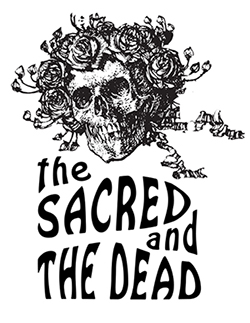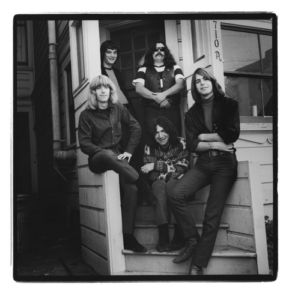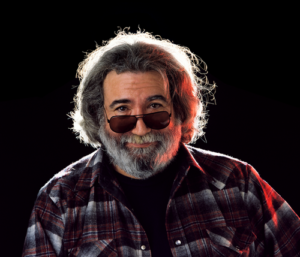Other times I can barely see.
Lately it occurs to me,
What a long, strange trip it’s been.”
~ “Truckin’”
As the Grateful Dead celebrate their 50th anniversary this year, their historical, cultural, and artistic influence is being discussed, debated, and delineated through commemorative concerts, academic conferences, books, box sets, and a feature-length documentary film.

A special series on religion and culture produced in collaboration with the Office of Religious Life at the University of Southern California
This new body of scholarly literature and pop cultural production reveals the Grateful Dead as a uniquely American phenomenon with an extraordinary American legacy. Indeed, as the de facto leaders of the largest counter-cultural movement in American history, the Grateful Dead have shaped and defined the idea of America for millions of people.
In so many ways, the Grateful Dead are the quintessential American rock ’n’ roll band, as they explicitly brought together the rich and diverse sounds of the American sonic landscape—folk, bluegrass, jazz, blues, country, gospel, and rock ‘n’ roll – in a way that no band ever has. Their music ventured to the outer limits of the American musical canon, seamlessly fusing uniquely American musical genres into something entirely new.
In memorializing Jerry Garcia, Bob Dylan lauded his friend’s virtuosity in American music: “There are a lot of spaces and advances between the Carter family, Buddy Holly and, say, Ornette Coleman, a lot of universes, but he filled them all without being a member of any school.”
Culturally, the Grateful Dead embraced the spirit of Americana, a spirit of possibility and freedom. As the band moved from the margins to the mainstream, attending one of their concerts became an essential American rite of passage. Through their articulation of the United States blues, the Grateful Dead navigated the politics of the culture ways by re-conceptualizing the promise of America for a new generation of seekers and explorers.
Another extremely important but too often overlooked aspect of the Grateful Dead’s legacy is their religious and spiritual significance, especially in the American context. For scholars of religion, the Grateful Dead experience looks like religion, as it contains within it all the traditional markers of religion—ritual, pilgrimage, belief, community, mythology, scripture, relics, miracles, and liturgy. And for millions of Deadheads, the Grateful Dead experience feels like religion—it does the work of the sacred in their lives—by embodying the core experiential aspects of religion, such as consciousness, mysticism, creativity, meaning, purpose, identity, transcendence, and prophecy.
In this regard, the members of the Grateful Dead are not prophetic in the sense that they are God’s anointed messengers on Earth; neither are they soothsayers who predict the future nor animated by any formal theological belief or conviction. However, they are prophetic in the way that the Indian Sufi master Hazrat Inayat Khan imagines prophets in the his classic work The Mysticism of Sound and Music, where he writes, “In fact, music excels religion, for music raises the soul of man even higher than the so-called external form of religion… That is why in ancient times, the greatest prophets were great musicians.”

Members of the Grateful Dead in San Francisco’s Haight Ashbury neighborhood in 1966. Photo by Herb Greene from the Grateful Dead Archive at UCSC. Used with the gracious permission of the photographer.
The members of the Grateful Dead did not set out to be religious figures and they certainly do not view themselves that way. In fact, on numerous occasions they vehemently have disagreed with the notion that they represent a new religious movement, and they are quite critical of those who view them as religious leaders.
However, despite their unequivocal rejection of the religious moniker, the band members all have spoken in great detail about the spiritual foundations of the Grateful Dead universe. Reflecting upon the music and message of the 1960s, Garcia said, “For me, the lame part of the Sixties was the political part, the social part. The real part was the spiritual part.”
For Garcia, the Grateful Dead’s music could serve as a “signpost to a new consciousness” by challenging the listener to become “an understanding molecule in evolution, a conscious tool of the universe.”
As the world’s most popular cult band, the Grateful Dead developed an extremely loyal and devout fan base that literally spent their lives following them from concert to concert, city to city, state to state, and country to country. Known as Deadheads, the devotees of the Grateful Dead collectively formed an intentionally itinerant community numbering in the tens of thousands, with their own customs, vernacular, art, and economy.
In his explanation of the lure of the Grateful Dead to thousands of Deadheads around the country, Garcia ruminated, “maybe we’re just one of the last adventures in America.” Indeed, the promise of a great American adventure animated Deadheads to undertake an annual pilgrimage across the country to hear the band play the music and the music play the band.
In his landmark study of pilgrimage, the anthropologist Victor Turner argued that pilgrimages enable and empower the process of communitas, or the creation of a community without a social hierarchy that is bound by shared principles, goals, and aspirations. According to Turner, the physical journey is only one level of the pilgrimage, which is at its core a spiritual journey. So going on tour with Grateful Dead is not just an exercise in community building and tribal identity, but more importantly, it is an opportunity for personal transformation and spiritual growth.
Perhaps no song better represents the role of pilgrimage in the Grateful Dead experience than “Truckin’” from their classic 1970 album American Beauty. The song’s lyrics offer a framework for a road trip adventure by transforming the American concert landscape into sacred geography for Deadheads.
Indeed, “Truckin’” references seven major American cities “involved in a typical daydream, and these cities were also regular stops on Grateful Dead tours. Accordingly, “Truckin’” lyrically provided a roadmap for the annual pilgrimage of Deadheads across the country.
In addition to amplifying an ethos of pilgrimage, “Truckin’” also is the most autobiographical Grateful Dead song, as the lyrics recount the band’s trials and tribulations on the road. The most famous of these incidents—their 1970 drug bust in New Orleans—is forever memorialized in the studio version:
“Sittin’ and starin’ out of the hotel window.
Got a tip they’re gonna kick the door in again.
I’d like to get some sleep before I travel,
But if you got a warrant, I guess you’re gonna come in.Busted, down on Bourbon Street,
Set up, like a bowlin’ pin.
Knocked down, it gets to wearin’ thin.They just won’t let you be, oh no.”
By situating the band’s travel experiences into a larger American story, “Truckin’” makes even more explicit the Grateful Dead’s unique place in America’s cultural mythology, a connection that was cemented permanently in 1997 when the Library of Congress declared “Truckin’” a national treasure.

Iconic portrait of Jerry Garcia by Herb Greene. Photo used with the gracious permission of the photographer.
So “Truckin’” is not just the narrative of an American band on the road, but it is also an aspiration for a uniquely American adventure where the road trip is a pilgrimage and the real journey is one of self-discovery.
The religious landscape of the United States has profoundly changed since the genesis of the Grateful Dead 50 years ago, especially in terms of the dramatic rise of the number of Americans who are no longer affiliated with traditional religious institutions or denominations.
In the absence of traditional religious affiliation, people are increasingly turning to popular culture to explore and interrogate the ultimate questions of meaning and purpose in their lives. That is why in the United States, there is now a Church of Elvis Presley and a Church of John Coltrane, the Church of the Latter-day Dude (aka “Dudeism”), a religion based on the Coen Brothers’ film The Big Lebowski and Oprah Winfrey is arguably the most important national spiritual leader.
That is why the Grateful Dead is not just a band, but also a new American religious community.
And “Truckin’” is not just a song, but also sacred text extolling the value and virtue of a new American pilgrimage, a journey that is at once physical, spiritual, and musical.


